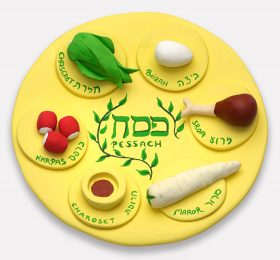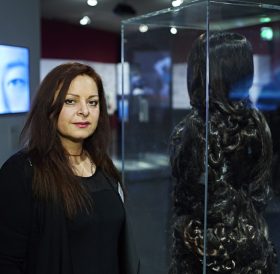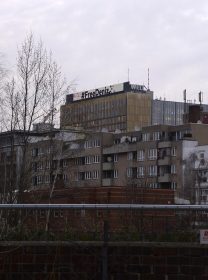
Shlomit Tulgan made this Seder plate from clay for our children’s exhibition on Passover; Jewish Museum Berlin, photo: Jens Ziehe.
It’s Seder and the family is getting together. Some are traveling from farther away, others are flourishing right here. At the table are escarole, lettuce, parsley, kohlrabi, Belgian endive, and dandelion. But what about horseradish and red radish? They’re both late this year.
The story of the plants and their fruits that have particular meaning on the Seder plate at Passover could be told in various similar ways. They all grow in the Diaspora Garden, which you can visit inside the W. Michael Blumenthal Academy at the Jewish Museum. → continue reading
Of Persian fairy tales and female self-determination

Artist Mandana Moghaddam standing next to her sculpture Chelgis I in the exhibition Cherchez la femme. Wig, Burqa, Wimple; Jewish Museum Berlin, photo: Yves Sucksdorff
In the course of the new exhibition Cherchez la femme – which deals with the covering of women within the idea of the monotheism of the three leading religions – we spoke with Iranian artist Mandana Moghaddam. Her artwork Chelgis (pronounced “Gelgis”) contributes to the concept of the exhibition in an impressive way and further stimulates the viewers’ own contemplation on the subject. Just in time for the exhibition’s opening we conducted a short interview with Mandana Moghaddam:
Dear Ms. Moghaddam, would you tell us a little bit about your artwork and the story of Chelgis?
I began my work by thinking of contemporary womens’ issues, examining them from different angles. When I drew the first sketch I saw the story of Chelgis – which means “40 braids” – right in front of me. → continue reading

View from the Academy of the Jewish Museum Berlin towards the Springer building with the lit-up sign, #FreeDeniz; Jewish Museum Berlin, photo: Stefanie Haupt
As I leave my office at the Jewish Museum Berlin, emerging from the W. Michael Blumenthal Academy onto the street, the hashtag “#FreeDeniz” beams towards me from an illuminated black-on-turquoise-green display on the Axel Springer building. The first time I saw it, I was cheered by the signal that the publishing house Axel Springer SE* was calling for the release of Die Welt’s correspondent in Turkey, Deniz Yücel. But each day seeing the display has gotten sadder. I’ve known Deniz Yücel since 2003, when — together with other German- and Turkish-speaking Berliners — he organized bilingual protests against the bomb attacks on the two Istanbul synagogues, Neve Shalom and Beth Israel, on November 15 of that year. Twenty-four people were killed in those attacks and at least 300 wounded.
Deniz and I haven’t had contact for quite awhile. But since mid-February, through the news of his imprisonment for “terrorist propaganda” and the car procession protests that followed it, as well as conversations with friends and of course the illuminated sign, memories from the period in 2003 and 2004 when we interacted almost weekly having been coming back. → continue reading


